Building TariPedia App as A Typical Balinese Performance Encyclopedia on Mobile Device Platform
on
p-ISSN: 2301-5373
e-ISSN: 2654-5101
Jurnal Elektronik Ilmu Komputer Udayana
Volume 8, No 2. November 2019
Building TariPedia App as A Typical Balinese Performance Encyclopedia on Mobile Device Platform
Muhammad Hanif Zulfikara1, I Gusti Agung Gede Arya Kadyanana2
aInformatics Department, Udayana University
Bali, Indonesia
Abstract
Indonesia is a country with a variety of cultures and arts. Traditional art dance is one of Indonesia's arts which is one of the important aspects in supporting Indonesian culture and even tourism. Traditional dance has a special attraction to be enjoyed while staying in the midst of rapid development. Therefore, the writer makes a market application that connects the studios, dance groups, and dancers with traditional dancer tenants. TariPedia makes it easy for studio owners, service providers, and event organizers to market their services so that they can be more easily reached by the public and can increase sales of their services with the payment feature through the application. Therefore by developing TariPedia with Prototyping Method and Java Language in its development, TariPedia will continue facilitates the community, especially in the fields of traditional dance and at the same time modernizing regional arts.
Keywords: Traditional Dancers, Information System, Prototyping, E-Ticket, Ensiklopedia
Traditional dance is one of Indonesia's arts which is one of the important aspects in supporting culture and even tourism in Indonesia. Traditional dance has a special attraction to be enjoyed even in the midst of the rapid development of the era.
Traditional dance performances are often one of entertainment in various events or activities, both formal and informal. On the other hand, many studios and dance groups that provide dance services to be used as a show at various events.
The island of Bali, or often referred to as the Island of the Gods, is one of Indonesia's icons which is thick with dance art. Dance has become an important aspect in supporting Balinese culture which is very influential in terms of customs, culture, and tourism. Balinese dance has a special attraction to be enjoyed despite being in the midst of the rapid development of technology, various kinds of art have emerged at this time and are increasingly sophisticated by utilizing existing technology. However, through our survey, we found a problem that will be a big challenge for the existence of Balinese Dance. As many as 75% of respondents said that currently Balinese Dance is increasingly eroded due to the lack of interest from the younger generation to find out and learn Balinese Dance due to the difficulty of getting information about Balinese dance. In addition, 65.9% of respondents said that they had an event involving dancers to fill an event at the event, but had difficulty finding information about dance studios that provided dancers' services
At present, information about studios and dance groups that provide traditional dance rental services is still very difficult to obtain. On the internet, information about renting traditional dance services is still in the form of general information, in other words the information contained is only in the form of contact information from providers of traditional dance rental services. In addition, studio information that rents out traditional dance services and dance attributes is still fragmented, so that people still find it difficult to access this information in one place providing information. At present, the community is still very difficult to get information about traditional dance events.
Based on this description the authors innovate to create a mobile-based application called "TariPedia" which is a place for various information related to dances as well as to rent traditional dance services and purchase tickets for traditional dance performance events online. Through the application "TariPedia" is expected to facilitate the public in renting traditional dance services and purchasing tickets for traditional dance performances events online only in the palm of their hand. Managers can get profit from the commission obtained from each transaction made through the application "TariPedia".
-
2. Research Methods
-
2.1 Use Case
-
2.2.1 Use Case Description
-
-
The following use case diagram from TariPedia
1) User, Event and Dance Management Login Use Case
|
Name |
Login |
|
Actor |
User, Dance Management, and Event Management |
|
Description |
User, Dance Management, and Event Management can login to enter the application. In this user login process the application will verify data from the user so that the application can find out the categories of users who want to enter the application |
|
Succesful Completion |
Login Succes |
|
Preconditon |
Users cannot enter the application yet |
|
Postcondition |
Users can access all features according to their respective access rights |
2) User, Event and Dance Management Registration Use Case
|
Name |
Registration |
|
Actor |
User, Dance Management, and Event Management |
|
Description |
User, Dance Management, and Event Management can register can register the user to get access rights and features desired and in accordance with the user's use |
|
Succesful Completion |
Registration Succes |
|
Preconditon |
Users cannot acces the application yet |
|
Postcondition |
Users can access all features according to their respective access rights |
3) User Dancer Rent Use Case
|
Name |
Dancer Rent |
|
Actor |
User |
|
Description |
Users can hire dancers by choosing a dancer, the dance they want, fill out the form provided and select a payment method |
|
Succesful Completion |
The user will get proof of payment and the user will be contacted by the dancer regarding the order details confirmation |
|
Preconditon |
The user is in the main menu and sees a list of dancers to choose from |
|
Postcondition |
The user gets proof of booking and will be contacted by the dancer |
4) User Dance E-Ticket Use Case
|
Name |
Dance E-Ticket |
|
Actor |
User |
|
Description |
Users can order dance tickets by selecting the desired dance event then pressing the "Buy Ticket" button then determine the ticket quantity, enter personal data, select the payment method and pay |
|
Succesful Completion |
Users get ticket booking details and get an E-Ticket which will be scanned by the dance event's barcode manager |
|
Preconditon |
Users are in the main menu and see a list of events to choose from |
|
Postcondition |
Users get order details and E-Ticket |
5) Event Management Add E-Ticket Use Case
|
Name |
Add E-Ticket |
|
Actor |
Event Management |
|
Description |
Event Management can make dance events |
|
Succesful Completion |
The user will get proof of payment and the user will be contacted by the dancer regarding the order details confirmation |
|
Preconditon |
The user is in the main menu and sees a list of dancers to choose from |
|
Postcondition |
The event has been created and the E-Ticket will appear in the Event List |
6) Event Management E-Ticket QR Code Scanning Use Case
|
Name |
E-Ticket QR Code Scanning |
|
Actor |
Event Management |
|
Description |
Event Management can scan QR codes on tickets obtained by the user when purchasing dance event tickets. |
|
Succesful Completion |
Scanning succesful |
|
Preconditon |
The user shows the QR Code on the E-Ticket and Event Management directs the camera to the QR Code on the ETicket |
|
Postcondition |
Successful scanning, details of the ticket order will appear which will be confirmed by Event Management |
7) Dance Management Add Dance Rental and Attributes Use Case
|
Name |
Add Dance Rent |
|
Actor |
Dance Management |
|
Description |
Dance Management can rent out traditional dance services and dance attributes and determine the rental price of the services being rented. |
|
Succesful Completion |
Dance Rent Added |
|
Preconditon |
Dance Management is in the main menu and opens my dance menu |
|
Postcondition |
The dance that has been added is ready to be rented by the user |
8) User View Dance List Use Case
|
Name |
View Dance List |
|
Actor |
User |
|
Description |
Dance Management can rent out traditional dance services and dance attributes and determine the rental price of the services being rented. |
|
Succesful Completion |
Dance Rent Added |
|
Preconditon |
Dance Management is in the main menu and opens my dance menu |
|
Postcondition |
The dance that has been added is ready to be rented by the user |
9) User View Dance Ensiklopedia Detail Use Case
|
Name |
Add Dance Rental and Attributes |
|
Actor |
Dance Management |
|
Description |
Dance Management dapat menyewakan jasa tari tradisional dan atribut-atribut tari serta menentukan harga sewa dari jasa yang disewakan. |
|
Succesful Completion |
Dance Rent Added |
|
Preconditon |
Dance Management is in the main menu and opens my dance menu |
|
Postcondition |
The dance that has been added is ready to be rented by the user |
10) User View Traditional Dance Studio Detail Use Case
|
Name |
Add Dance Rental and Attributes |
|
Actor |
Dance Management |
|
Description |
Dance Management dapat menyewakan jasa tari tradisional dan atribut-atribut tari serta menentukan harga sewa dari jasa yang disewakan. |
|
Succesful Completion |
Dance Rent Added |
|
Preconditon |
Dance Management berada di menu utama dan membuka menu tari saya |
|
Postcondition |
Tari yang telah ditambahkan sudah siap untuk di sewa ole user |
Use-case diagrams are UML diagram models that are used to describe the expected functional requirements of a system. Use-case diagrams emphasize "who" does "what" in a software system environment to be built.
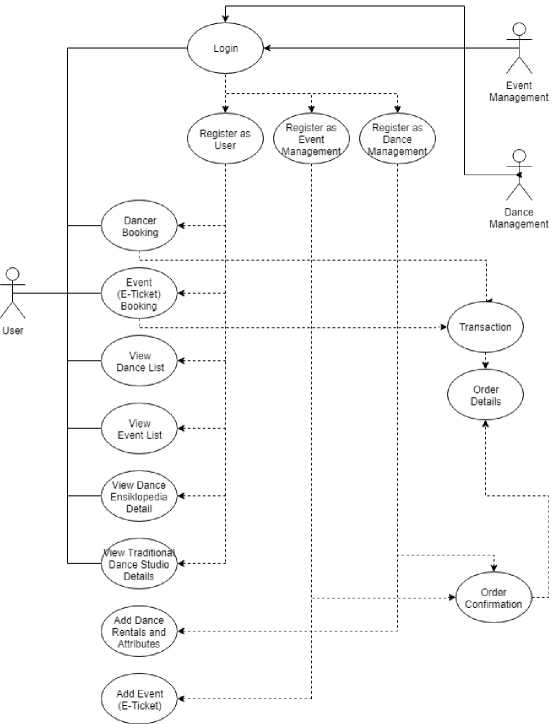
Figure 1. Use Case Diagram
From the Use Case diagram above it can be explained that the User, Event Management, and Dance Management are part of the user, where the user can do several things to the system, namely :
-
1. Login, the user can log in if the user has already registered in the system
-
2. Registration, the user can register first before logging in
-
3. Dance Booking, users can register the services of dancers and dances that you want to rent.
-
4. Event (E-Ticket Booking), users can register the event you want to create or in the title.
-
5. View Dance List, users can see the dance list created by Event Management
-
6. View Event List, users can purchase tickets for events based on tickets to enter, or book a place in events based on free to the public (free entry)
-
7. View Dance Encyclopedia Details, users can see the dance details in the dance Encyclopedia
-
8. View Traditional Dance Studio Details, users can see the details of Traditional Dance Studio
-
9. Add Dance Rentals and Attributes, Dance Management can add dances and dance attributes that are rented
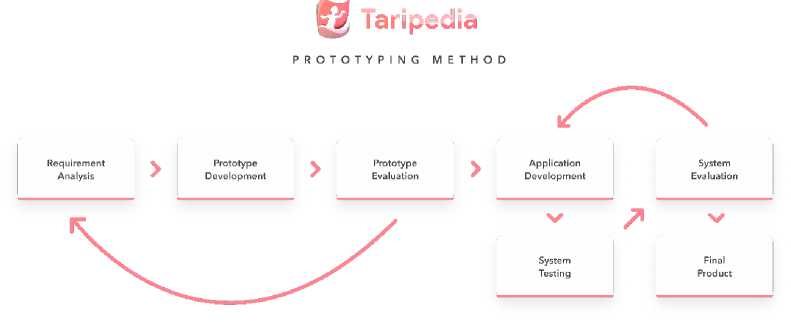
Figure 2. Protoyping Method Diagram
The developer defines the format of the software / software, identifying the needs and the system created.
Build prototyping by making temporary designs that focus on serving the user (for example creating input and output formats).
This stage is carried out by the user, whether the prototyping made / built, is in accordance with the wishes and needs of the user. If it is not appropriate, prototyping will be revised by repeating the previous steps. But if it is suitable, then the next step will be implemented.
At this stage the agreed prototyping is translated into the appropriate programming language.
After the system has become a software that is ready to use, the software must be tested before being used. This aims to minimize software errors. Testing is done by Black Box, White Box, Architecture testing, Base path and others.
At this stage the user evaluates the system that has been created as desired. If not, then the developer will repeat steps to 2.2.4 and 2.2.5. But if so, step 2.2.7 will be taken.
Software that has been tested and accepted for use is ready for use.
This section contains the result and discussion of the research and can be presented as description, charts or figures.
After the design process is carried out periodically, then the program implementation is carried out on the design that has been made into a mobile-based application that is built with the Swift and Java programming languages.
On the registration page, users can create an account in accordance with the permissions desired by the user. Users can choose to be Users, Event Managers and Dancers. After creating an account, users can log in using the Email and Password that has been previously registered

Figure 3. Register Page
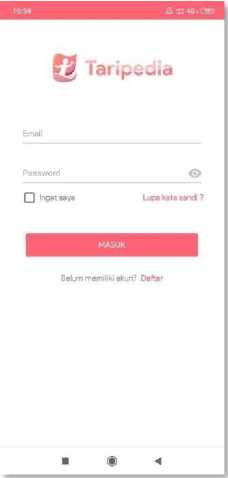
Figure 4. Login Page
On the home page, users can access all the features possessed by TariPedia, such as Event, Dance, Studio, Tutorial, Rental and Transaction. In addition, on the Home Page there are highlights events that will be held in the near future
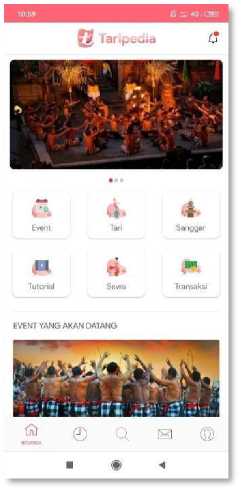
Figure 5. Home Page
On the Event List Page, displays the events uploaded by Event Management. There are 2 types of events, namely Paid Events and Unpaid Events
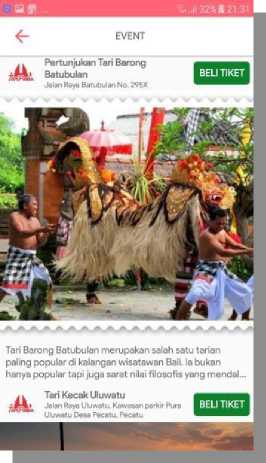
Figure 6. Event List Page
4) E-Ticket Transaction Page
When a user wants to make a Paid Event Booking, the user will be directed to the Transaction page. On this page the user is required to fill 4 steps, and fill in every form provided
- g_____________________________ip ■■' i
|
<- Pilih Tlket —CED— PilihTiket InfoPersonaI Konfirmasi Bayar Tiket Pertunjukan Tari Barong Batubulan Harga PerTiket Rp. 60.000 Kuantitas ^- j 2 [ ψj Total Harga Rp. 120.000 Figure 7. E-Ticket – Choose Ticket ^- Konfirmasi -^CED--CZD--CID—CZD PilihTlket InfoPersonaI Konfirmasi Bayar PIUH METODE PEMBAYARAN ∣⅛⅛ ATM Bersama ⅛BN∣ ATMBhII JBCl MMBCA raw⅛ ATMMondtI KONFIRMASI Kuantitas 2 Tiket Total Harga Figure 9. E-Ticket - Confirmation |
^- Informasi Personal ““CO--CID—CID—CID— PilihTiket InfoPersonaI Konfirmasi Bayar NAMA Shieldy b E-MAlL Figure 8. E-Ticket – Personal Information ^- Pembayaran PilihTiket InfoPersonaI Konfirmasi Bayar Cara Pembayaran Lewat ATM BNI:
Figure 10. E-Ticket - Pay |

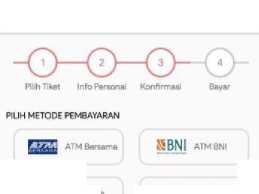

Detail Tiket
Nama Event
Festival Kesenian Bali
Harga Tiket
Rp. 20.000
Waktu & Tanggal
18.00 - 2 Juni 2019
Tompat
Lapangan Renon
Nama
Gede Widiastawan
Seat
24B
KONFIRMASI TIKET
Figure 13. QR Code – Ticket Details
-
3.2. Program Testing
-
3.2.1 Register Page
-
|
Input Data |
Expected |
Observation |
Conclusions |
|
Email, Name, User Category, Password |
The system will direct the user to the Users / Event Management and Dancer main pages |
Displays the main page / homepage |
Confirmed |
3.2.1 Login Page
|
Input Data |
Expected |
Observation |
Conclusions |
|
Email, Password |
The system will direct the user to the main page |
The system directs the user to the main page |
Confirmed |
3.2.1 Event List Page
|
Input Data |
Expected |
Observation |
Conclusions |
|
Click the "Event" button |
The system will display a list of Events that have been created by Event Management |
The event list will appear on the event list page |
Confirmed |
3.2.1 QR Code Scanning
|
Input Data |
Expected |
Observation |
Conclusions |
|
JPEG Picture |
QR Code will be scanned and details will appear from the customer |
Ticket reservation details appear |
Confirmed |
3.2.1 Transaction Page
|
Input Data |
Expected |
Observation |
Conclusions |
|
E-Ticket Quantity, User Name, E-Mail, Payment Method |
Transaction Details, E-Ticket |
Transaction Details, E-Ticket |
Confirmed |
Based on the results of the activities carried out, as for the conclusions that can be obtained is, TariPedia system is a mobile-based application that is engaged in the rental of traditional dancers and purchase of dance event tickets. The linkage between 1 feature and the other features has been proven in the system testing process which involves 6 main features that are connected so that they are able to project transactions online and display event organizers by category.
References
-
[1] Ustia, Nurul, S. T. Endah Sudarmilah, and M. Eng. Edugame Mengenal Tari Tradisional Indonesia Melalui Augmented Reality Berbasis Android. Diss. Universitas Muhammadiyah Surakarta, 2016.
-
[2] Damayanti, Nita Rosa. "E-Tiket Tari Barong Dan Keris Web Engineering." JUSIM (Jurnal Sistem Informasi Musirawas) 2.1 (2017): 59-64.
-
[3] Fauziah, Desianny Amalia, Eko Supraptono, and Raden Kartono. "Pengembangan Ensiklopedi Digital Tari Daerah Jawa Tengah Berbasis Android Dengan Metode Linear Sequential Model (the Development of Android Based Digital Encyclopedia of Central Java Traditional Dance Using Linear Sequential Model)." Jurnal Ilmu Pengetahuan dan Teknologi Komunikasi20.1 (2018): 77-91.
175
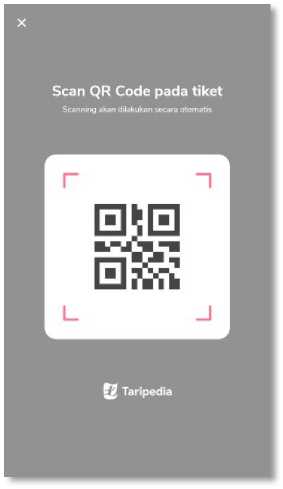

Discussion and feedback